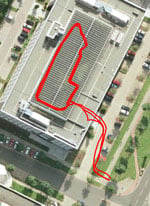Omnidirectional Pedestrian Navigation for First Responders
It might be assumed that dead reckoning approaches to pedestrian navigation could address the needs of first responders, including fire fighters. However, conventional pedestrian dead reckoning approaches with body-mounted motion sensors can fail when used with the irregular walking patterns typical of urban search and rescue missions. In this project, a technique using shoe-mounted sensors is explored and we show that the technique is very accurate in terms of distance travelled and can handle many arbitrary manoeuvres, such as tight turns, side/back stepping and stair climbing.
Stéphane Beauregard of the University of Bremen: “In our approach, a motion measurement unit (MMU) (containing tri-axial accelerometers, rate gyros and magnetometers) is solidly attached to, or mounted in, footwear. Standard strap-down mechanization equations, threshold-based stance detection and zero-velocity updates allow for the direct calculation of foot displacements between footfalls. These latter are determined simply by double integrating the accelerations rotated to the world frame.
Xsens' MTi IMU was the main instrument for our experiments. The sensor was attached to the shoe using the laces and the data cable run up the pant leg. Data was logged on a carried laptop and post-processed using routines written in Matlab. A uBlox GPS receiver was used to collect ground truth data for experiments performed outdoors. The Xsens software was used for retrieving calibrated sensor values as well as the orientation estimates (i.e. rotation matrix)."
Customer
WearIT@Work, EU Integrated Project
Technologie-Zentrum Informatik, Bremen University, Bremen, Germany
